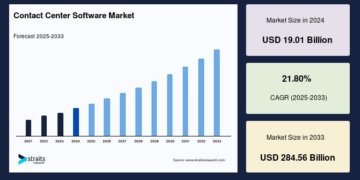According to a recent report published by Allied Market Research, titled, “Humidity Sensor Market by Product, Type, and End Use: Opportunity Analysis and Industry Forecast, 2020-2027,” the global humidity sensor market was valued at $4.07 billion in 2019, and the market size is projected to reach $11.85 billion by 2027, growing at a CAGR of 14.2% from 2020 to 2027.
Download Research Report Sample & TOC : https://www.alliedmarketresearch.com/request-sample/1708
In 2019, Asia-Pacific dominated the market, contributing more than 50% share of the overall revenue, followed by North America. Rapid growth of industrialization and increase in population are some key factors responsible for the growth of the humidity sensor market. Asia-Pacific is the largest contributor to the automotive industry with growing economy and advancements in regular framework of the humidity sensors. China, Japan, and India are the major countries experiencing major humidity sensor market growth during the forecast period. Japan and China are technologically advanced countries, and thus exhibit high demand for humidity sensors.
A humidity sensor is an electronic component that senses, measures, and reports water vapor and air temperature. The humidity sensor functions by carefully monitoring environmental conditions and alerting the user of any alarming conditions. It detects any change in the electrical currents or temperature in the air. Accuracy, linearity, reliability, repeatability, and response time of humidity sensors are some of the important parameters considered for its selection.
Factors such as increase in demand for small-sized humidity sensor, surge in installation of personal weather stations, and developments in the automotive sector drive the growth of the global humidity sensor market. However, the need to improve technical specifications of humidity sensor is expected to hamper the humidity sensor market growth to a certain extent. Furthermore, development and adoption of vertical farming and precise farming are expected to offer lucrative opportunities for the growth of the humidity sensor market globally.
Request For Customization @ https://www.alliedmarketresearch.com/request-for-customization/1708
According to Shantanu Sachan, Lead Analyst, Semiconductor and Electronics at Allied Market Research, “The increase in adoption of IoT and AI is one of the major humidity sensor market trend fuels the growth of the global humidity sensor market. In addition, the leading market players are investing in R&D in developing ultra-thin and miniaturized humidity sensors owing to upsurge in demand for ultra-thin and compact electronics. However, these factors are technically challenging market players to improve the technical specifications of humidity sensors in terms of changing and rigorous environment in which these sensors perform. Moreover, these improved sensors are to be integrated with other electronics with ease and efficiency. In addition, there is a rise in popularity for electric vehicles with improved air conditioning system for passengers as well as well-maintained environment for electronic components. This propels the growth of the humidity sensor market.”
Region wise, the market is analyzed across North America, Europe, Asia-Pacific, and LAMEA. Asia-Pacific was the highest revenue generator in 2019, accounting for $2.09 billion, and is estimated to garner $6.65 billion by 2027, growing at a CAGR of 15.59%. This is attributed to the fact that humidity sensor systems find their major application in automotive sector in the region. However, North America is expected to account for $2.58 billion by 2027, growing at a CAGR of 13.73%.
The humidity sensor market is segmented into product, type, end use, and region. By product, the market is bifurcated into relative and absolute humidity sensors. By type, the market is segregated into digital and analog. The digital segment accounted for the highest humidity sensor market share in 2019. By end use, the market is classified into residential, commercial, automotive, industrial, agriculture, weather station, and healthcare. By region, the humidity sensor market is analyzed across North America (U.S., Canada, and Mexico), Europe (UK, Germany, France, and rest of Europe), Asia-Pacific (China, India, Japan, South Korea, and rest of Asia-Pacific), and LAMEA (Latin America, Middle East, and Africa).
Inquiry Before Buying : https://www.alliedmarketresearch.com/purchase-enquiry/1708
Key Findings Of The Study
• By product, the relative humidity sensors segment held the highest revenue of $3.46 billion in 2019 and contributed a major part in humidity sensor market size.
• By type, the digital humidity sensor segment held the highest revenue share of the market in 2019, generating $2.44 billion as per the humidity sensor market analysis.
• By end use, the industrial segment held the highest revenue share of the market in 2019, generating $993.1 million.
• By region, Asia-Pacific is expected to dominate the market, garnering a major share during the forecast period.
The key players profiled in the humidity sensor market include Amphenol Advanced Sensors, Guangzhou Aosong Electronics Co., Ltd., Honeywell International Inc., Laird Connectivity, Michell Instruments, Renesas Electronics Corporation, Schneider Electric, Sensirion AG Switzerland, TE Connectivity, and Texas Instruments Incorporated.
Report Overview: https://www.alliedmarketresearch.com/humidity-sensor-market
Contact:
David Correa
1209 Orange Street,
Corporation Trust Center,
Wilmington, New Castle,
Delaware 19801 USA.
Int’l: +1-503-894-6022
Toll Free: +1-800-792-5285
Fax: +1-800-792-5285
help@alliedmarketresearch.com
Web:https://www.alliedmarketresearch.com
About Us:
Allied Market Research (AMR) is a full-service market research and business-consulting wing of Allied Analytics LLP based in Wilmington, Delaware. Allied Market Research provides global enterprises as well as medium and small businesses with unmatched quality of “Market Research Reports” and “Business Intelligence Solutions.” AMR has a targeted view to provide business insights and consulting to assist its clients to make strategic business decisions and achieve sustainable growth in their respective market domain.
We are in professional corporate relations with various companies, and this helps us in digging out market data that helps us generate accurate research data tables and confirms utmost accuracy in our market forecasting. Each and every data presented in the reports published by us is extracted through primary interviews with top officials from leading companies of domain concerned. Our secondary data procurement methodology includes deep online and offline research and discussion with knowledgeable professionals and analysts in the industry.
This release was published on openPR.














